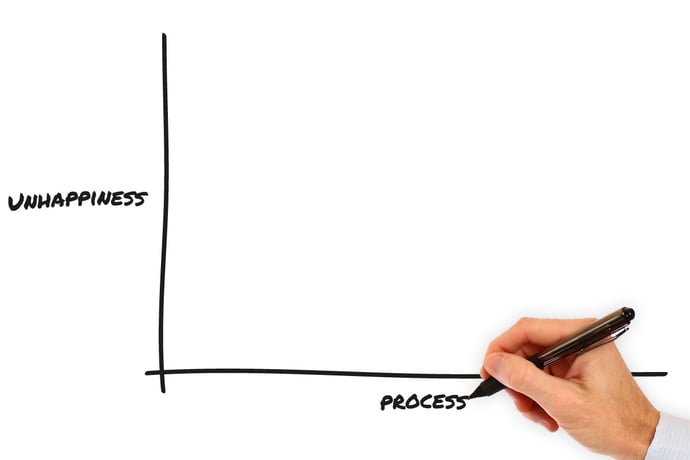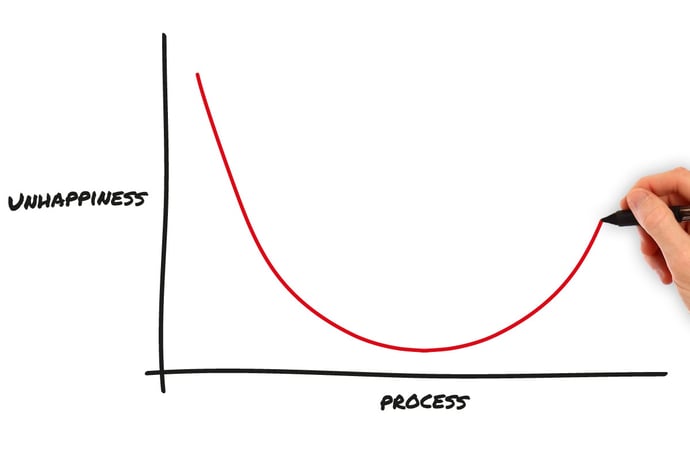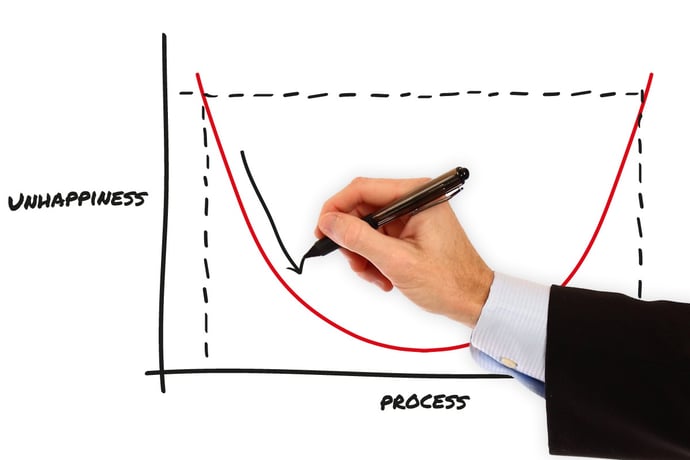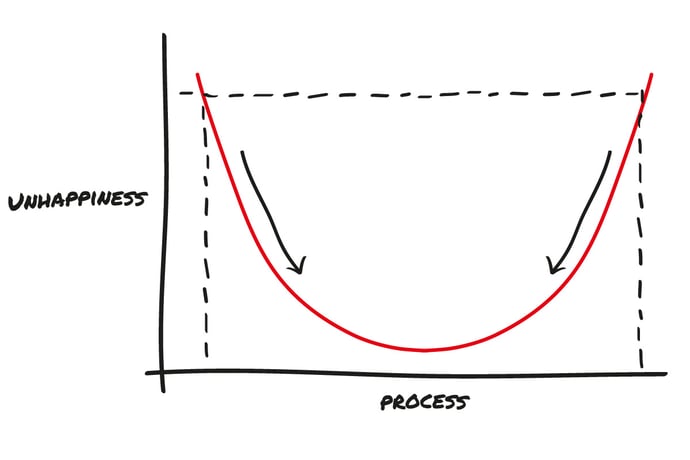The 3 Bears Approach to Process Management: Too Hot, Too Cold & Just Right
Michael CousinsI have a favourite graph, a thing of great meaning and insight in relation to Business Process Management and the need for control and governance in business. It is the best, simplest indicator I have found for finding the sweet spot in process management. Not too hot, not too cold...but just right.
It was shown to me by a Finnish gentleman working at Nokia in the early 2000s. He was rather a dour man, and had a pessimistic outlook on things.
“Everyone is unhappy” he said, “especially at work!”
I did take issue with him at the time regarding this statement, and still do. I do not believe it to be true.
But he continued by drawing two axes on the board behind him, the X and the Y axes.

“Look he said, on the X axis, there is Process. The amount of Process a business has in place. And on the Y axis is Unhappiness - how unhappy the staff in the business are.”
He labelled the axes…

And then he drew a curve on the chart. It looked like a ‘u’ shape, but with more gentle curvature.

The 3 Bears Approach to Process Management: Too Hot, Too Cold and Just Right
He went on to explain:
“When a business starts out, it is bedlam, there is very little Process. Every time something goes wrong, the team in place has to figure out from scratch what to do about it. Every time the team wants to accomplish something new, they have to sit down and work through the process from scratch. It is a very demanding, challenging environment, lots of unhappy people working lots of hours and compensating for the business’ lack of Process with their own energy and time reserves. Staff turnover tends to be high, burnout happens, most start-ups fail.”
He drew a dashed line from near the top of the Y axis to the top of the left branch of the u, and then dropped it to the x axis to emphasise the point that low process (too cold) = high unhappiness.
“It is headless chicken syndrome” he said, “no control, little governance and completely inadequate levels of Process. It is highly innovative though, literally everyone is inventing all the time.”
“But what about the other extreme?” he said.
He then drew a 2nd dashed line from the top left of the Y axis to the right branch of the u, and dropped it down to the x axis - High process (too hot) = high unhappiness.
“Here you have the case that there is way too much Process, and again, everyone is unhappy! Nobody has any authority to make decisions. There are 6 forms to fill in every time somebody wants to achieve something. People just do what they are told. Creativity is stifled, and motivation to improve is killed off because people feel powerless automatons that are at work simply to turn the handles.”
I was definitely starting to warm to this guy, he was onto something. I felt uncomfortable about the belief that everyone was unhappy all the time, but I kind of liked the association with morale and Process, it made a lot of sense to me.
“When there is too little process management, it needs to be increased. It is inappropriate, it places too many demands on staff to adapt and causes issues through lack of governance. ”

“And when there is too much process management, it is also inappropriate and needs to be reduced. It is overly controlling the workforce and they will be unhappy. ”

If you would like to find out once and for all where your processes are on the 'too hot' and 'too cold' spectrum then download this Business Analysis White Paper...
“Process Management, Process Improvement…, call it what you will, it all has an impact on the volume of Process in place and a direct effect on the morale of the workforce.”
I was sold… He didn’t stop there though.
Process Management: The Effects of Getting it Wrong
“Look”, he said, “the Y axis can be many other things.”
He started to write the word “Waste” on the Y axis. “Too little Process is wasteful because the wheel keeps being reinvented, mistakes are repeated, cost of quality failure is high. Too much Process is wasteful because it is overly bureaucratic to no economic advantage.”
He then went on to put “Defects”, “Staff Churn” and “Costs” on the Y axis.
“Much of what is wrong in a business correlates directly with the absence of sufficient Process, or the presence of too much. A business needs enough Process for staff to feel supported, but not so much that they feel controlled.”
What About Innovation?
“It is all about the appropriate levels of Process to the business environment,” he said, “or to the specific team within the business.”
“If I am a passenger on a jumbo jet coming in to land, the last thing on earth I want is for the Captain of the plane to experiment with the landing Process. Innovation is completely inappropriate, and you want the pilot to do exactly the same thing every time. In that environment, more Process is necessary than you would normally encounter. On the other hand, in a medical team that is at the forefront of surgical medicine and trying to find new ways to treat illnesses, they must do something new for every new condition they encounter. In this environment, it is not about following checklists and procedures, it is about inventing new solutions to new problems.”
“It doesn’t matter that the level of Process is one situation is greater than another, what matters is that the level is right for that specific situation. If it is right, appropriate innovation can happen.”
Yes, thought I to myself. That is absolutely correct.
And that is how my favourite graph came into being.
Finding Your Own Process Management Sweet Spot
Navigating the waters of process can be difficult for any organisation without the added pressure of finding the right temperature so you can enjoy the swim. Business Process Management Systems help with effective understanding, management and improvement of processes without the need of going to extremes.
If you would like to find out how other businesses managed to navigate those same waters then read our Business Process Improvement e-book which shows how 8 companies went from process problem, to improvement triumph...
Related articles:
How much does Business Process Management (BPM) software cost?
7 Key Questions to ask when shopping for Business Process Management (BPM) software
Written by Michael Cousins
Mike founded Triaster in 1994. A thought leader in business improvement, he has led Triaster ever since, spearheading its development of beautifully engineered business improvement software, that is both full of the functionality required by business analysts and that end users find really easy to use.

